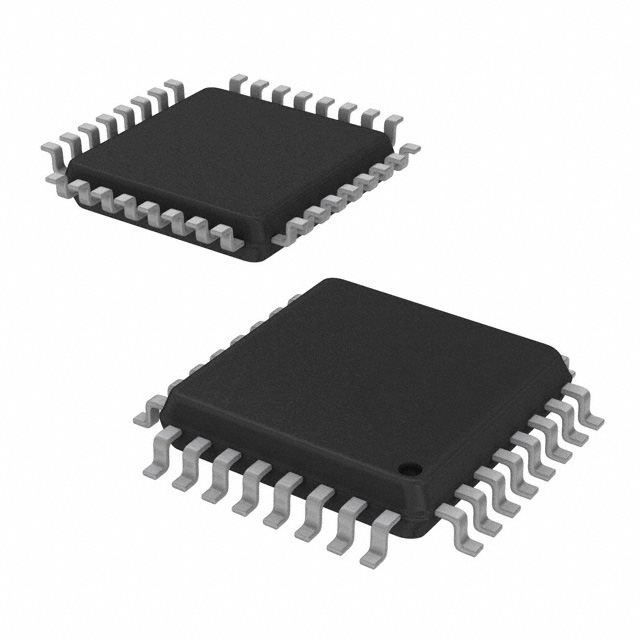Viz Specifikace pro podrobnosti o produktu.

EFM8BB31F64G-B-QFP32
Product Overview
Category
The EFM8BB31F64G-B-QFP32 belongs to the category of microcontrollers.
Use
This microcontroller is commonly used in various electronic devices and systems for controlling and processing data.
Characteristics
- High-performance 8-bit microcontroller
- Low power consumption
- Integrated peripherals for enhanced functionality
- Small form factor
- Robust and reliable design
Package
The EFM8BB31F64G-B-QFP32 comes in a Quad Flat Package (QFP) with 32 pins.
Essence
The essence of this microcontroller lies in its ability to provide efficient control and processing capabilities in a compact package.
Packaging/Quantity
The EFM8BB31F64G-B-QFP32 is typically packaged in reels or tubes, with a quantity of 250 units per reel/tube.
Specifications
- Architecture: 8-bit
- Flash Memory: 64 KB
- RAM: 4 KB
- Operating Voltage: 2.7V to 3.6V
- Clock Speed: Up to 50 MHz
- Digital I/O Pins: 28
- Analog Input Channels: 12
- Communication Interfaces: UART, SPI, I2C
- Timers/Counters: 4
- ADC Resolution: 12-bit
- PWM Channels: 4
- Operating Temperature Range: -40°C to +85°C
Detailed Pin Configuration
- P0.0 - GPIO
- P0.1 - GPIO
- P0.2 - GPIO
- P0.3 - GPIO
- P0.4 - GPIO
- P0.5 - GPIO
- P0.6 - GPIO
- P0.7 - GPIO
- P1.0 - GPIO
- P1.1 - GPIO
- P1.2 - GPIO
- P1.3 - GPIO
- P1.4 - GPIO
- P1.5 - GPIO
- P1.6 - GPIO
- P1.7 - GPIO
- P2.0 - GPIO
- P2.1 - GPIO
- P2.2 - GPIO
- P2.3 - GPIO
- P2.4 - GPIO
- P2.5 - GPIO
- P2.6 - GPIO
- P2.7 - GPIO
- RESET - Reset Pin
- VDD - Power Supply
- GND - Ground
- XTAL1 - Crystal Oscillator Input
- XTAL2 - Crystal Oscillator Output
- AVDD - Analog Power Supply
- AGND - Analog Ground
- ADC0 - Analog-to-Digital Converter Input
Functional Features
- High-speed processing capabilities
- Low power consumption for energy-efficient operation
- Integrated peripherals such as UART, SPI, and I2C for communication
- Analog-to-Digital Converter (ADC) for precise analog signal measurement
- Timers/Counters for accurate timing and event counting
- PWM channels for generating precise pulse-width modulation signals
Advantages and Disadvantages
Advantages
- Compact size and low power consumption make it suitable for portable devices
- Integrated peripherals reduce the need for external components
- High-performance architecture enables efficient data processing
- Wide operating temperature range allows for use in various environments
Disadvantages
- Limited flash memory and RAM capacity may restrict complex applications
- 8-bit architecture may not be sufficient for certain advanced tasks
- Availability of alternative models with more features or higher performance
Working Principles
The EFM8BB31F64G-B-QFP32 operates based on an 8-bit architecture, where instructions and data are processed in 8-bit chunks. It utilizes a combination of hardware and software to execute tasks, including fetching instructions from memory, performing calculations, and controlling external devices. The microcontroller's integrated peripherals and I/O pins enable it to interact with the external world, making it suitable for a wide range of applications.
Detailed Application Field Plans
The EFM8BB31F64G-B-QFP32 finds applications in various fields, including:
- Consumer Electronics: Used in smart home devices, wearable technology, and remote controls.
- Industrial Automation: Employed in control systems, motor drives, and monitoring equipment.
- Automotive: Integrated into automotive electronics for engine control, dashboard displays, and infotainment systems.
- Internet of Things (IoT): Enables connectivity and control in IoT devices such as sensors, actuators, and gateways.
- Medical Devices: Utilized in medical instruments, patient monitoring systems, and diagnostic
Seznam 10 běžných otázek a odpovědí souvisejících s aplikací EFM8BB31F64G-B-QFP32 v technických řešeních
Sure! Here are 10 common questions and answers related to the application of EFM8BB31F64G-B-QFP32 in technical solutions:
Q: What is the EFM8BB31F64G-B-QFP32 microcontroller used for? A: The EFM8BB31F64G-B-QFP32 microcontroller is commonly used in various technical solutions, including industrial automation, consumer electronics, and Internet of Things (IoT) applications.
Q: What is the maximum clock frequency supported by the EFM8BB31F64G-B-QFP32? A: The EFM8BB31F64G-B-QFP32 microcontroller supports a maximum clock frequency of 50 MHz.
Q: How much flash memory does the EFM8BB31F64G-B-QFP32 have? A: The EFM8BB31F64G-B-QFP32 microcontroller has 64 KB of flash memory.
Q: Can I use the EFM8BB31F64G-B-QFP32 for analog signal processing? A: Yes, the EFM8BB31F64G-B-QFP32 has built-in analog peripherals such as ADCs (Analog-to-Digital Converters) and DACs (Digital-to-Analog Converters), making it suitable for analog signal processing.
Q: Does the EFM8BB31F64G-B-QFP32 support communication protocols like UART, SPI, and I2C? A: Yes, the EFM8BB31F64G-B-QFP32 microcontroller supports UART, SPI, and I2C communication protocols, allowing easy integration with other devices.
Q: What is the operating voltage range of the EFM8BB31F64G-B-QFP32? A: The EFM8BB31F64G-B-QFP32 operates within a voltage range of 1.8V to 3.6V.
Q: Can I use the EFM8BB31F64G-B-QFP32 in battery-powered applications? A: Yes, the low power consumption and voltage range of the EFM8BB31F64G-B-QFP32 make it suitable for battery-powered applications.
Q: Does the EFM8BB31F64G-B-QFP32 have any built-in security features? A: Yes, the EFM8BB31F64G-B-QFP32 microcontroller provides hardware-based security features like a unique device identifier (UID) and a hardware CRC engine.
Q: Is there any development toolchain available for programming the EFM8BB31F64G-B-QFP32? A: Yes, Silicon Labs provides a comprehensive development toolchain, including an Integrated Development Environment (IDE) called Simplicity Studio, which supports programming and debugging of the EFM8BB31F64G-B-QFP32.
Q: Can I find application notes and example code for the EFM8BB31F64G-B-QFP32? A: Yes, Silicon Labs provides extensive documentation, including application notes and example code, to help developers get started with the EFM8BB31F64G-B-QFP32 microcontroller.

